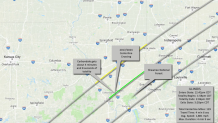Chicagoans could catch an extraordinary sight this weekend as a total lunar eclipse will be overhead on Sunday, but will the clouds get in the way?
Cloud cover is expected to hang around long enough to obscure at least the start of the eclipse in Chicago, but residents in the city should be able to pick up the scene as the evening goes along.
It’s more likely Chicago residents will see it near the ending of totality than at the start.
One thing the National Weather Service and NBC 5 Storm Team Meteorologist Pete Sack agree on: the further west you are, the better chance you have to see the eclipse.
Most of Illinois should be clear by midnight, but by then totality will be over.
Unfortunately for Indiana residents, it appears that cloud cover will keep residents from seeing the eclipse.
Local
According to the Adler Planetarium, a Flower Moon will pass into Earth's shadow at 8:32 p.m. Sunday to create a total lunar eclipse.
"A total lunar eclipse occurs when the Moon is fully engulfed by the Earth’s shadow," the Adler Planetarium wrote online. "Once totality begins, the Moon can appear reddish due to our atmosphere scattering away the bluer rays of the Sun’s light, just like the Sun appears reddish right before sunset."
Feeling out of the loop? We'll catch you up on the Chicago news you need to know. Sign up for the weekly Chicago Catch-Up newsletter.
May's Flower Moon is also called the Blood Moon by some due to the red color it gives off. However, that isn't unique to this year as the moon typically appears red during a lunar eclipse, the planetarium wrote.
This interactive map shows which stage of the eclipse will be visible from your location.
The planetarium noted that the eclipse will begin at 8:32 p.m., then move into a partial eclipse at 9:27 p.m. Totality is set to start at 10:29 p.m. and end at 11:53 p.m. The partial lunar eclipse will then end 12:55 a.m. on May 16.
According to Northwestern University, which is planning to host a public event surrounding the eclipse on its Evanston campus, such moments are "fairly rare."
“This is a chance to witness how the Earth, moon and sun are all connected,” Michael Smutko, director of the Dearborn Observatory and professor of instruction in physics and astronomy in Northwestern’s Weinberg College of Arts and Sciences, said in a statement. “The three must be aligned to form a straight line, so the Earth’s shadow completely envelops the moon, for a total lunar eclipse.”
But for those who miss it, another total lunar eclipse is expected to be at least partially-visible from Chicago on Nov. 8.
In about two years, a total solar eclipse will also be visible from Illinois.
On April 8, 2024, the event will be the last visible total solar eclipse from the U.S. until 2045.
More 31 million people across 13 states — including Illinois — live in "the path of totality" for the event — meaning those places will see 100% totality.
According to the website nationaleclipse.com, in Illinois, the state of totality will begin on April 8, 2024 at 1:58 p.m. and end at 2:06 p.m.




